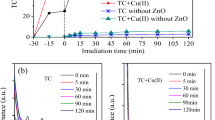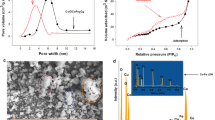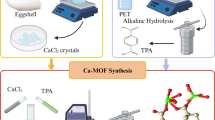Abstract
Adsorption process is suitable to the advanced treatment of tetracycline antibiotics (TCs; including tetracycline (TTC), oxytetracycline (OTC), and chlortetracycline (CTC)) in poultry wastewater. In this research, Mn oxide-doped Cu oxide (MODCO) was synthesized and used for the removal of TTC, OTC, and CTC. According to the XRD and SEM analysis results, MODCO has an amorphous crystal structure and is formed by the aggregation of nano-sized particles with a uniform distribution of Cu and Mn elements. In addition, MODCO has a BET surface area of 67.7 m2/g and a pHIEP value of 7.8. The results of batch experiments illustrated that the reaction rates for the removal of three TCs were in the order of OTC > CTC > TTC. In addition, the theoretical maximum amounts of TTC, OTC, and CTC adsorbed on MODCO were determined to be 2.90 mmol/g, 4.15 mmol/g, and 2.20 mmol/g via the Langmuir model, respectively. The optimal removal performances of TCs were achieved in the pH range of 6~9, and the coexistence of anions posed an unnoticeable effect on the removal efficiencies. The spectroscopic analysis results demonstrated that the removal mechanism of TCs was mainly attributed to surface complexation. Furthermore, a part of TCs may be decomposed by Mn oxides during the removal process according to the UV spectrogram results. Overall, MODCO has exhibited a great potential for the removal of TCs from aqueous solution.









Similar content being viewed by others
References
Alegakis AK, Tzatzarakis MN, Tsatsakis AM, Vlachonikolis IG, Liakou V (2000) In vitro study of oxytetracycline adsorption on activated charcoal. J Environ Sci Health B 35(5):559–569
Bangari RS, Sinha N (2019) Adsorption of tetracycline, ofloxacin and cephalexin antibiotics on boron nitride nanosheets from aqueous solution. J Mol Liq 293:111376
Belhouchet N, Hamdi B, Chenchouni H, Bessekhouad Y (2019) Photocatalytic degradation of tetracycline antibiotic using new calcite/titania nanocomposites. J Photochem Photobiol A Chem 372:196–205
Cao J, Xiong Z, Lai B (2018) Effect of initial pH on the tetracycline (TC) removal by zero-valent iron: adsorption, oxidation and reduction. Chem Eng J 343:492–499
Chang P, Li Z, Yu T, Munkhbayer S, Kuo T, Hung Y, Jean J, Lin K (2009) Sorptive removal of tetracycline from water by palygorskite. J Hazard Mater 165:148–155
Chen J, He F, Zhang H, Zhang X, Zhang G, Yuan G (2014) Novel core–shell structured Mn–Fe/MnO2 magnetic nanoparticles for enhanced Pb(II) removal from aqueous solution. Ind Eng Chem Res 53:18481–18488
Chen J, Wang J, Zhang G, Wu Q, Wang D (2018) Facile fabrication of nanostructured cerium-manganese binary oxide for enhanced arsenite removal from water. Chem Eng J 334:1518–1526
De Sousa DNR, Insa S, Mozeto AA, Petrovic M, Chaves TF, Fadini PS (2018) Equilibrium and kinetic studies of the adsorption of antibiotics from aqueous solutions onto powdered zeolites. Chemosphere 205:137–146
Dedryvere R, Foix D, Franger S, Patoux S, Daniel L, Gonbeau D (2010) Electrode/electrolyte interface reactivity in high-voltage spinel LiMn1.6Ni0.4O4/Li4Ti5O12 lithium-ion battery. J Phys Chem C 114:10999–11008
Dong G, Huang L, Wu X, Wang C, Liu Y, Liu G, Wang L, Liu X, Xia H (2018) Effect and mechanism analysis of MnO2 on permeable reactive barrier (PRB) system for the removal of tetracycline. Chemosphere 193:702–710
Evangelin C, Naren S, Dharmendirakumar M (2012) Comparison of the surface features of the three chemically modified silk cotton hull activated carbons. Orient J Chem 28:1761–1768
Gao Y, Li Y, Zhang L, Huang H, Hu J, Shah SM, Su X (2012) Adsorption and removal of tetracycline antibiotics from aqueous solution by graphene oxide. J Colloid Interface Sci 368:540–546
Gao B, Chen W, Liu J, An J, Wang L, Zhu Y, Sillanpää M (2018) Continuous removal of tetracycline in a photocatalytic membrane reactor (PMR) with ZnIn2S4 as adsorption and photocatalytic coating layer on PVDF membrane. J Photochem Photobiol A Chem 364:732–739
Grujić S, Vasiljević T, Laušević M (2009) Determination of multiple pharmaceutical classes in surface and ground waters by liquid chromatography–ion trap–tandem mass spectrometry. J Chromatogr A 1216:4989–5000
Gu C, Karthikeyan KG (2005) Interaction of tetracycline with aluminum and Iron hydrous oxides. Environ Sci Technol 39:2660–2667
Homem V, Santos L (2011) Degradation and removal methods of antibiotics from aqueous matrices–a review. J Environ Manag 92:2304–2347
Kang J, Liu H, Zheng Y, Qu J, Chen JP (2010) Systematic study of synergistic and antagonistic effects on adsorption of tetracycline and copper onto a chitosan. J Colloid Interface Sci 344:117–125
Kang J, Liu H, Zheng Y, Qu J, Chen JP (2011) Application of nuclear magnetic resonance spectroscopy, Fourier transform infrared spectroscopy, UV–visible spectroscopy and kinetic modeling for elucidation of adsorption chemistry in uptake of tetracycline by zeolite beta. J Colloid Interface Sci 354:261–267
Kavitha P, Jayaraj S, Raghav D (2012): Optical properties and density functional theory study of single crystal glycine. International Journal of Applied Physics and Mathematics, 293-295
Kim Y, Lee K, Choi K (2016) Effect of runoff discharge on the environmental levels of 13 veterinary antibiotics: a case study of Han River and Kyungahn Stream, South Korea. Mar Pollut Bull 107:347–354
Kushikawa RT, Silva MR, Angelo ACD, Teixeira MFS (2016) Construction of an electrochemical sensing platform based on platinum nanoparticles supported on carbon for tetracycline determination. Sensors Actuators B Chem 228:207–213
Li K, Yediler A, Yang M, Schulte-Hostede S, Wong MH (2008) Ozonation of oxytetracycline and toxicological assessment of its oxidation by-products. Chemosphere 72:473–478
Li G, Gao S, Zhang G, Zhang X (2014) Enhanced adsorption of phosphate from aqueous solution by nanostructured iron(III)–copper(II) binary oxides. Chem Eng J 235:124–131
Li J, Zhang H, Chen Y, Luo Y, Zhang H (2016) Sources identification of antibiotic pollution combining land use information and multivariate statistics. Environ Monit Assess 188:430
Liao P, Zhan Z, Dai J, Wu X, Zhang W, Wang K, Yuan S (2013) Adsorption of tetracycline and chloramphenicol in aqueous solutions by bamboo charcoal: a batch and fixed-bed column study. Chem Eng J 228:496–505
Lin HB, Huang WZ, Rong HB, Mai SW, Hu JN, Xing LD, Xu MQ, Li WS (2015) Improving cyclic stability and rate capability of LiNi0.5Mn1.5O4 cathode via protective film and conductive polymer formed from thiophene. Solid State Electron 19:1123–1132
Liu Z, Ma R, Osada M, Iyi N, Ebina Y, Takada K, Sasaki T (2006) Synthesis, anion exchange, and delamination of Co−Al layered double hydroxide: assembly of the exfoliated nanosheet/polyanion composite films and magneto-optical studies. J Am Chem Soc 128:4872–4880
Liu H, Yang Y, Kang J, Fan M, Qu J (2012) Removal of tetracycline from water by Fe-Mn binary oxide. J Environ Sci 24:242–247
Liu T, Wu K, Xue W, Ma C (2015) Characteristics and mechanisms of arsenate adsorption onto manganese oxide-doped aluminum oxide. Environ Prog Sustain Energy 34:1009–1018
Liu X, Huang D, Lai C, Zeng G, Qin L, Zhang C, Yi H, Li B, Deng R, Liu S, Zhang Y (2018a) Recent advances in sensors for tetracycline antibiotics and their applications. TrAC Trends Anal Chem 109:260–274
Liu H, Yang Y, Sun H, Zhao L, Liu Y (2018b) Effect of tetracycline on microbial community structure associated with enhanced biological N&P removal in sequencing batch reactor. Bioresour Technol 256:414–420
Liu H, Sun H, Zhang M, Liu Y (2019) Dynamics of microbial community and tetracycline resistance genes in biological nutrient removal process. J Environ Manag 238:84–91
Luengo CV, Volpe MA, Avena MJ (2017) High sorption of phosphate on Mg-Al layered double hydroxides: kinetics and equilibrium. J Environ Chem Eng 5:4656–4662
Ma J, Zhou B, Zhang H, Zhang W, Wang Z (2019) Activated municipal wasted sludge biochar supported by nanoscale Fe/Cu composites for tetracycline removal from water. Chem Eng Res Des 149:209–219
Mahamallik P, Saha S, Pal A (2015) Tetracycline degradation in aquatic environment by highly porous MnO2 nanosheet assembly. Chem Eng J 276:155–165
Matsushima M (1963) The hydration of some organic compounds in an aqueous solution. I. Studies of aliphatic aldehydes by Raman-effect observation. B Chem Soc Jpn 36:954–960
Panda D, Kumar EA (2017) Surface modification of zeolite 4A molecular sieve by planetary ball milling. Mater Today Proceeded 4:2
Pillewan P, Mukherjee S, Roychowdhury T, Das S, Bansiwal A, Rayalu S (2011) Removal of As(III) and As(V) from water by copper oxide incorporated mesoporous alumina. J Hazard Mater 186:367–375
Premarathna KSD, Rajapaksha AU, Adassoriya N, Sarkar B, Sirimuthu NMS, Cooray A, Ok YS, Vithanage M (2019) Clay-biochar composites for sorptive removal of tetracycline antibiotic in aqueous media. J Environ Manag 238:315–322
Rubert PJA (2006) Kinetics of oxytetracycline reaction with a hydrous manganese oxide. Environ Sci Technol 40:7216–7221
Saitoh T, Shibata K, Hiraide M (2014) Rapid removal and photodegradation of tetracycline in water by surfactant-assisted coagulation–sedimentation method. J Environ Chem Eng 2:1852–1858
Selmi T, Sanchez-Sanchez A, Gadonneix P, Jagiello J, Seffen M, Sammouda H, Celzard A, Fierro V (2018) Tetracycline removal with activated carbons produced by hydrothermal carbonisation of Agave americana fibres and mimosa tannin. Ind Crop Prod 115:146–157
Song X, Liu D, Zhang G, Frigon M, Meng X, Li K (2014) Adsorption mechanisms and the effect of oxytetracycline on activated sludge. Bioresour Technol 151:428–431
Srinivasan G, Suresh G, Sumalatha M (2015) Synthesis, growth and characterization of organic nonlinear optical crystal of glycine sodium acetate (GSA) for optical applications. Mater Today: Proc 2:4592–4599
Tang W, Zeng G, Gong J, Liang J, Xu P, Zhang C, Huang B (2014) Impact of humic/fulvic acid on the removal of heavy metals from aqueous solutions using nanomaterials: a review. Sci Total Environ 468-469:1014–1027
Wang Z, Chen Q, Zhang J, Dong J, Yan H, Chen C, Feng R (2019a) Characterization and source identification of tetracycline antibiotics in the drinking water sources of the lower Yangtze River. J Environ Manag 244:13–22
Wang W, Han Q, Zhu Z, Zhang L, Zhong S, Liu B (2019b) Enhanced photocatalytic degradation performance of organic contaminants by heterojunction photocatalyst BiVO4/TiO2/RGO and its compatibility on four different tetracycline antibiotics. Adv Powder Technol 30:1882–1896
Watkinson AJ, Murby EJ, Kolpin DW, Costanzo SD (2009) The occurrence of antibiotics in an urban watershed: from wastewater to drinking water. Sci Total Environ 407:2711–2723
Xu Z, Fan J, Zheng S, Ma F, Yin D (2009) On the adsorption of tetracycline by calcined magnesium-aluminum hydrotalcites. J Environ Qual 38:1302–1310
Xu Z, Song X, Li Y, Li G, Luo W (2019) Removal of antibiotics by sequencing-batch membrane bioreactor for swine wastewater treatment. Sci Total Environ 684:23–30
Yan C, Yang Y, Zhou J, Liu M, Nie M, Shi H, Gu L (2013) Antibiotics in the surface water of the Yangtze Estuary: occurrence, distribution and risk assessment. Environ Pollut 175:22–29
Zhang D, Niu H, Zhang X, Meng Z, Cai Y (2011) Strong adsorption of chlorotetracycline on magnetite nanoparticles. J Hazard Mater 192:1088–1093
Zhang G, Ren Z, Zhang X, Chen J (2013) Nanostructured iron(III)-copper(II) binary oxide: a novel adsorbent for enhanced arsenic removal from aqueous solutions. Water Res 47:4022–4031
Zhang LL, Ma YL, Cheng XQ, Zuo PJ, Cui YZ, Guan T, Du CY, Gao YZ, Yin GP (2014) Enhancement of high voltage cycling performance and thermal stability of LiNi1/3Co1/3Mn1/3O2 cathode by use of boron-based additives. Solid State Ionics 263:146–151
Zhang Z, Liu H, Wu L, Lan H, Qu J (2015) Preparation of amino-Fe(III) functionalized mesoporous silica for synergistic adsorption of tetracycline and copper. Chemosphere 138:625–632
Zhao Y, Geng J, Wang X, Gu X, Gao S (2011) Tetracycline adsorption on kaolinite: pH, metal cations and humic acid effects. Ecotoxicology 20:1141–1147
Zhou L, Ying G, Liu S, Zhang R, Lai H, Chen Z, Pan C (2013) Excretion masses and environmental occurrence of antibiotics in typical swine and dairy cattle farms in China. Sci Total Environ 444:183–195
Funding
This work was financially supported by the Natural Science Foundation of China (Grant No. 51578440), the Key Research and Development Project of Shaanxi Province (Grant No. 2019ZDLSF05-03), and the National Key Research and Development Project (Grant No. 2019YFD1100102-04).
Author information
Authors and Affiliations
Corresponding author
Additional information
Responsible editor: Tito Roberto Cadaval Jr
Publisher’s note
Springer Nature remains neutral with regard to jurisdictional claims in published maps and institutional affiliations.
Electronic supplementary material
ESM 1
(DOC 2344 kb)
Rights and permissions
About this article
Cite this article
Wu, K., Zhang, C., Liu, T. et al. The removal of tetracycline, oxytetracycline, and chlortetracycline by manganese oxide–doped copper oxide: the behaviors and insights of Cu-Mn combination for enhancing antibiotics removal. Environ Sci Pollut Res 27, 12613–12623 (2020). https://doi.org/10.1007/s11356-020-07810-8
Received:
Accepted:
Published:
Issue Date:
DOI: https://doi.org/10.1007/s11356-020-07810-8




